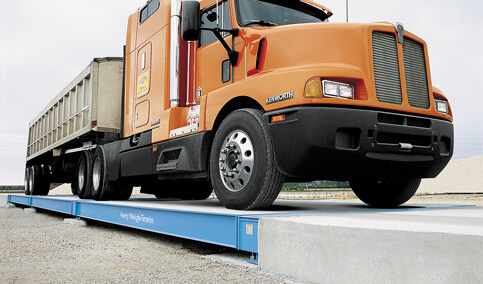
Image Source: averyweigh-tronix.com
As a truck scale owner, you’re aware of your scale’s uses and capabilities, but have you considered how slight errors and improper calibration could contribute to potential revenue loss? If your business is weighing relatively low cost products, you may think a few hundred pounds off will not affect your bottom line. But, if your scale is weighing a high volume of trucks on a daily basis, you could be looking at a potential loss of thousands of dollars over the course of months and years.
Below is an actual example provided by a business selling aggregate materials showing how their inaccurate scale could have lost their company over $250,000 annually.
Aggregate Business Example
| Weighing Volume | 300 trucks/day | |
| Weighing Frequency | 5 days/week= | 1,500 weighs per week
|
| 4 weeks/month= | 6,000 weighs per month | |
| Product Value | $27.50/ton= | $.01375 per lb. |
| Inaccuracy per Weigh | 250 lbs. light x $.01375= | $-3.4375 per weigh |
This inaccuracy could have resulted in a total revenue loss of $247,500 in one year.
Now that you are aware of how inaccurate/out of calibration truck scales can affect your bottom line, it’s important to learn ways to maintain the accuracy of your truck scale and how to obtain the best results from your scale.
Let’s review what happens after the initial purchase of your legal-for-trade truck scale.
Initial Certification
When a legal-for-trade scale is initially installed, a certified scale provider licensed by the Department of Agriculture Weights and Measures of the governing state, tests its performance. This test certifies the accuracy of the scale and ensures that it is legal-for-trade and legally ready to weigh trucks.
(Any U.S. business that buys, sells or charges based upon weight must use a “Legal for Trade” scale. Legal for trade scales are tested and sealed by government agencies insuring the scale’s legal accuracy.)
The initial calibration, however, does not guarantee that it will remain in calibration and accurate. Many factors can contribute to a scale losing calibration. A licensed scale service provider can advise ways to keep your scale in optimum weighing condition and maintaining accurate calibration.
Periodic Calibration
Calibration plays a key role in ensuring you’re not overcharging your clients or losing your hard-earned money. Since the accuracy of truck scales depends on various external factors, it will need periodic testing. To help you decide how often you should have your truck scale calibrated, you may take into consideration the following four items.
- Number of weight measurements done per day
- How many days your scale is used annually
- Price of the products to be weighed
- Acceptable error rate
Five Elements of a Scale Maintenance Program
- State Licensed Service Agents: Scales can be calibrated and “placed into service” by licensed scale service agents. A scale that is “placed into service” means it legally meets the calibration standards and business can be conducted using the scale.The division of Weights and Measures by the governing state may at any time test legal-for-trade scales to ensure the scale is in calibration. Scales that fail the accuracy test performed by Weights and Measures can be “red-tagged”, or taken out of service. Before the company is able to conduct business using the scale, it must be reinstated or “placed into service” after successful calibration by a licensed scale service agent.
- Certified Test Weights: Calibration should always be performed using certified test weights. Established companies typically have their test weights certified and adjusted every year or every other year. Before hiring a scale service provider, ensure their weights used have been properly certified. You can request a copy of the certification documentation.
- Thorough Testing Process: Before testing, note the platform length and number of sections it contains, i.e. the number of load cells which the load is transferred to. The NIST Handbook 44 mandates load cells also called ‘strain gauges’ must be calibrated if they fail a strain test.Rather than calibrating against a certified weight, load points are calibrated to ensure that each section registers exactly the same weight, or within the specifications issued by sanctioned organizations or NIST Handbook 44.Handbook 44 is published by the National Institute of Standards and Technology (NIST) as part of the responsibility for cooperation with States in securing uniformity of weights and measures laws and methods of inspection.
- Inspection Services: While calibration is essential, a good scale service provider also includes visual inspections to detect faults as part of truck scale maintenance visits.Be sure your provider checks for:
- Overall condition
- Apparent damage
- Clearance
- Corrosion
- Debris and dirt build-up
- Regulatory conformance
- Grounding
- Safety issues
- Electronic components and wiring
- Reporting: A quality service provider and a good maintenance program are essential to the accuracy, calibration and functionality of your truck scale. Be sure you are receiving detailed documentation from your provider advising what was done to your scale during services.After maintenance or calibration is performed on your truck scale, your scale provider should provide you with a thorough report documenting what was done to the scale. It should include details such as test results before (as found) and after (as left) each calibration, any changes or adjustments and a summary of recommendations based on the findings after the service.
Quality Scales Unlimited can help you with this process and provide you with the best scale maintenance service. Contact our sales team for more details.




